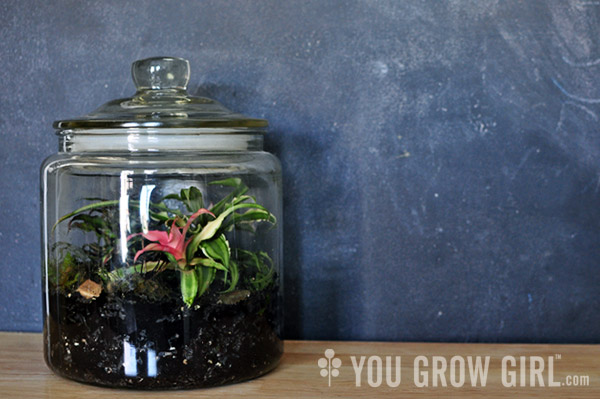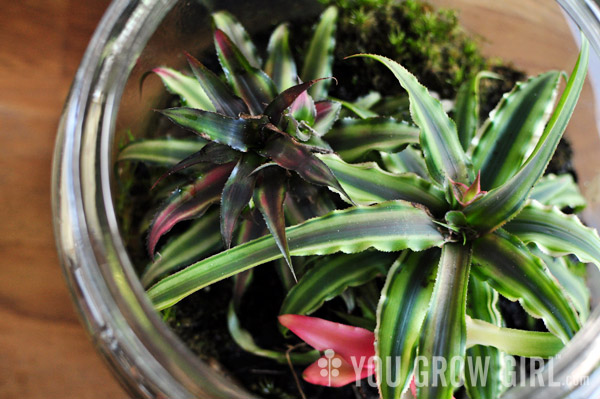
Ground control to Major Tom.
Perhaps it is the trippy name or the reference to outer space, but David Bowie comes to mind whenever I look at the little cluster of earth stars aka cryptanthus that I keep in a terrarium. In reality, the common name of this unusual Bromeliad family plant has a much more terrestrial origin that references the way that it grows very low to the ground with leaves that spread out to form star-like shapes. What’s unusual about this Bromeliad is that it grows in soil, rather than attached to trees or rocks as many others do. So in essence it is very literally an earth star.
According to, A Gardener’s Handbook of Plant Names: Their Meanings and Origins, the genus name cryptanthus is broken down into two parts: krypto, from the Greek meaning “to hide” and anthos, a flower, meaning that the flowers are hidden among the bracts.
And the stars look very different today.
Neglecting all of that history, my brain shall heretofore refer to this beautifully patterned and unusual plant as The Space Oddity.

A Mostly Hands-off Houseplant
As far as houseplants go, this one is a breeze to grow, especially in the self-contained and high-moisture world that exists inside a terrarium. Cryptanthus require lots of humidity. I have grown them both inside and out of a terrarium and I never have any problem with either method during the humid summer months. Guess which ones are still alive at the end of a long, dry winter indoors?
In fact, I’ve found that terrarium-grown earth stars are so easy to care for that once set-up, almost zero work is required to maintain them. I am not exaggerating for effect. A friend of mine told me that she kept a few alive in a terrarium for 20 years and hardly touched them at all! I started this terrarium 2 years ago (I think) and often forget about the plant for long stretches of time. The trick to this hands-off method is to be sure that they don’t get too hot inside the glass. For that reason, I try to keep mine in bright, but indirect light and watch that summer temperatures do not exceed 75-80 degrees F inside the glass. In extreme summer heat I have propped the lid open to cool things down. I also move the terrarium around the house seasonally to correspond with the changing light and heat, but you may not need to do that if you have a spot with fairly stable summer through winter conditions.
I grow mine in a terrarium with a lid, so poor air circulation and stagnant, sopping wet soil is something to watch for. For that reason, I tend to keep the lid propped open slightly, especially during the hotter months. However, the lid has been known to slip down into place by its own weight and I haven’t noticed any issues when that occurred, as long as the soil moisture was well-balanced.
How to Grow an Earth Star in a Terrarium
- Moisture: Soil must be kept moist at all times. If you do not grow in a terrarium with a lid, make sure to mist the leaves regularly and carefully pour a small amount of water onto the soil. You want the soil to feel like a damp sponge that has been wrung out. You can also try placing a saucer over the top of the container to increase humidity.
- Prefer 60-85 degrees F, but to be safe, I try to keep under the maximum when growing in a terrarium with a lid. Do not allow the plant to freeze.
- Soil: Loose and light. Unlike most bromeliads, earth stars require soil depth to support their root systems so choose a deep container. A commercially prepared African violet mix is a good choice.
- Fertilizing: When grown in a terrarium, they don’t need much if any at all. Without drainage holes, salts from commercial fertilizers can build up in the soil and harm the plant. Too much fertilizer will also cause the plant to grow too quickly, lose its tight rosette form, and possibly exceed the terrarium size. I added some worm castings to the soil at planting time along with a bit of dry sea kelp and I have NOT fertilized since. If growing in a pot (NOT a terrarium), I would provide a very diluted solution of sea kelp and fish emulsion (1/4 strength given to normal houseplants) once or twice during the summer months when there is more heat and light and the plant is actively growing.
- Terrarium Options: The terrarium I have shown is a glass apothecary or candy container that I found at a thrift store for a few bucks. Your terrarium can have a lid or not.
- Too Much Moisture: Can cause root rot. Try propping the lid open a little so that some air circulation can get inside and dry the soil slightly.
- Too Much Light: Will be obvious because the plant leaves will start to look bleached out and unhealthy.
Do you have moss growing next to it, in the terrarium? Does that survive well?
I do. The moss came with another plant so I put it in there for the heck of it. It does well. I actually have another, smaller jar with just moss in it!
I’m going to try it! Thanks :)
So where does one buy these earth stars? Have been thinking of starting one.
Here in Toronto I purchased mine at Plant World. That was some time back so I’d call to confirm whether or not they still have them. In general, I see them at garden centers that carry houseplants that are a little beyond the usual tropical trees.